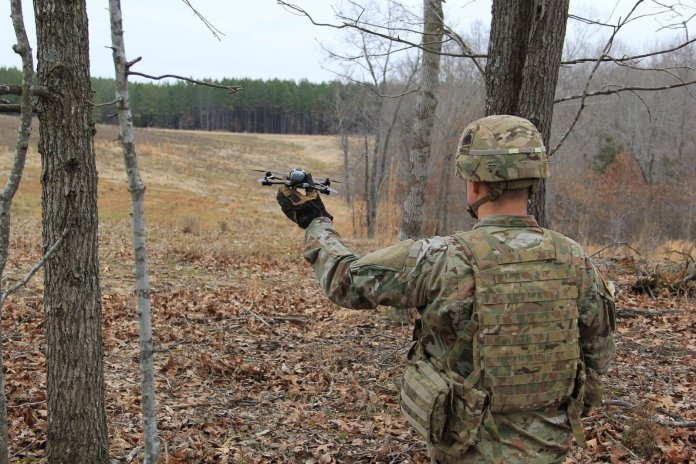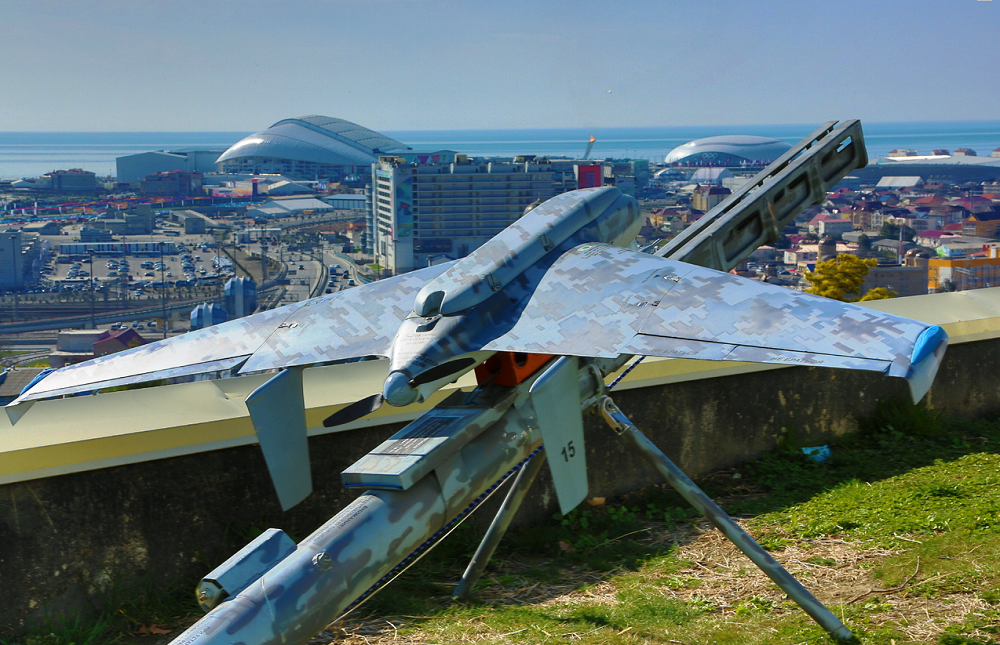
Published in the October/November 2020 Issue – Unmanned aerial vehicles can be employed from the smallest to largest military formations, to meet a developing range of mission profiles.
The Unmanned Aerial Vehicle (UAV) is influencing the conduct of ground warfare much as the initial introduction of the airplane did in World War I. Just as the flimsy balsa and fabric biplanes provided a new and, to those in the trenches, a seemingly all encompassing perspective of the ground battlefield so too does the threat of the UAV. Coupled with today’s technologies such as advanced high resolution cameras, on-board navigation, and digital data-links the UAV offers real-time information to its user far beyond the line-of-sight. The new found application of the UAV on the front lines is partly possible due to the introduction of smaller air platforms but it is equally the result data digitalisation that allows real-time local control and presentation of video imagery to soldiers even in austere environments.
In the last decade the UAV has evolved from simply an information gathering asset to a lethal enabler as it has been coupled with massed area indirect fire weapons like multiple launch rocket systems or precision guided ordnance. The deadly effect of this combination was dramatically demonstrated in the Ukraine when on 11 July 2014 Russian BM-21 Grad rocket artillery executed a mass attack on Ukrainian mechanised battalions assembling outside Zelenopillya after they were located by UAVs. US Army Colonel Liam Collins and Captain Brandon Morgan pointed out in their 22 January 2019 article, King of Battle: Russia Breaks Out the Big Guns, published in AUSA.org that “Russia [has] mastered integrating network of UAVs, forward observers, and dire direction centres directly with rocket and cannon batteries.” In addition, “the Russian Army is fielding its artillery [and associated UAV assets] directly to manoeuvre battalions, providing maximum responsiveness when short windows of opportunity present themselves…This unparalleled responsiveness allows forces to quickly fix and destroy an opposing force with minimal need for a lengthy decision-making process or complex schemes of manoeuvre”.
The use of massed artillery has been a mainstay of Russian tactics for nearly a century. The Katyuscha multiple rocket launcher inflicted similar destruction on German forces in 1944. However, it has become even more deadly today with the critical difference being the presence of the UAVs.
Omnipresence
The UAV appears to offer what every soldier and commander since Genghis Khan has wished, the ability to see beyond the next hill or tree line. To gain real-time information on the opponent’s troops, guns, and equipment and their dispositions day or night. The platform that best provides these insights to the local commander are not are the high flying persistent platforms like the Northrop Grumman RG-4 Global Hawk operating at up to 60,000 feet (18,000 metres) but rather the smaller tactical UAVs that operate just above the battlespace.
The tactical UAS operates forward on the battlefield often from undeveloped sites with minimal supporting facilities. These platforms fall within the US classifications of Group 1 – with a maximum weight of 20lbs (9kg) and operating altitude below 1,200ft (366m); Group 2 – weighing up to 55lbs (25kg) and 3,500ft (10,670m) altitude; and Group 3 at up to 1,320lbs (600kg) and 18,000ft (5,500m). Key differentiators are if the platform is fixed wing or rotary and if it is hand or catapult launched or conventional take-off. These, however, look at the UAV from a technical aspect when perhaps a clearer approach to understanding their contribution is to review them based on the unit level at which each is actually employed.
Squad UAVs
The UAV used at the squad and team level faces significant design challenges. It must be simple to operate, easy to carry, require minimal support, and yet be rugged and reliable. Their task is straight forward; to avoid surprises by preceding the squad and uncovering what is around the next bend, in the tree line, or even in a building. Referred to as Micro or Nano UAVs, the smallest and likely the most utilised is the Black Hornet from FLIR Systems. This palm size rotor craft has a 25 minute flight time and can send encrypted infrared and colour high definition images and video up to 2km. Navigation is simplified by using Global Navigation Satellite System (GNSS) with Vision Based Navigation that operates even in Global Positioning System (GPS) denied or indoor environments. Black Hornet has been widely adopted with over 19 NATO militaries as well as Indian forces. Another Niño is the AeroVironment Snipe, a foldable miniature (5oz) quadcopter with up to 30 minutes endurance.

The US Marines selected a redesign of a commercial UAV for its squads, fielding the Instant Eye. The small quad-copter is offered in several models with the Mark-3 GEN5-D1 being the smallest in the family at 250grams. Tom Vaneck, vice president at Instant Eye Robotics shared: “The need for a discrete aerial platform that can operate close to a target undetected is of critical importance. The Mark 3’s small size, low audible and visual signature assures this.” The US Marines dedicate one squad member to its operation.
Company to Battalion UAVs
For larger formations UAVs and deployed with greater range, endurance and more sensor options. These then require several soldiers to manpack and operate them. Many of these fixed wing models forgo any need for a launcher and are simply thrown into the air by a single person. These UAVs resemble recreational model airplanes although with much more sophisticated navigation, sensor packages and communication data links. The AeroVironment RQ-11 Raven is representative of this class. The platform comes in a single soldier portable carry case and is assembled on site. Hand launched it can remain aloft for up to 90 minutes typically flying about 500ft (150m) above ground with its electric push motor propeller make for quiet flight. Its standard sensor package includes day colour and thermal cameras on a 360 degree gimbal and when fitted with a Harris Small Secure Digital Data Link it permits beyond line-of-sight communications.

Alternately vertical take-off and landing (VTOL) UAVs have become increasingly fielded at this level. Quad-Copters have the advantage of requiring little space to take-off or land making them ideal for use in forests, urban areas or to be carried and operated from vehicles. The benefits of VTOL have become clear from actual field use with a number of fixed wing UAV firms now adapting hand-launched UAVs to vertical operation. They have also developed designs that seek to bridge the capabilities of the two configurations as shown in AeroVironment’s Quantix RECON which incorporates a fixed wing/VTOL hybrid that takes off vertically but will fly horizontally.
Brigade to Division UAVs
A critical difference in the UAV supporting operations at this level is the need for significantly greater mission flight times, normally 18 to 24 hours allow which allows loiter time for constant surveillance of a target. Larger UAVs mean sensor payloads beyond just electro-optics to include synthetic-aperture radar, foliage penetrating LiDAR, laser designators, and other packages. The Boeing Insitu trailer launched RQ-21A Blackjack with a 16ft (4.9m) wingspan carrying over 39lbs 18kg is an example that was first employed in Iraq in 2014. Another is the US Army Shadow tactical UAV which uses a runway. However, the Army has been looking at moving to a replacement that does not require a prepared strip. Candidates being considered include the Martin UAV V-Bat and the Aerosonde Hybrid Quad by Textron, L3 Harris’s FVR-90, and Arcturus UAV JUMP20. Operational user evaluations are ongoing in 2020.

Russian UAVs
The Russian Army was an early adaptor of UAVs for tactical reconnaissance employing its Strizj and Reys in the Russo-Georgian War in 2008 though with limited success due to their design. A major lesson learned from these and “subsequent operations in Syria and the Ukraine”, according to Samuel Bendett of the Centre for Naval Analysis, was the importance of signature management: “This has seen Russian development of hybrid drone engines to ensure quiet operation by using electric/petrol or variable performance petrol/kerosene.”
The Russian adoption of the UAV for tactical operations has been vigorous. Increasingly brigades have a UAV company with its platoons structured around each various UAV type and range. Extensive use has been made of the Granat series mini class and Orlan-10 short/mid-range UAVs in artillery spotting. These UAVs communicate directly to forward positioned artillery reconnaissance vehicles which then pass target data to battery fire control centres. On the Ukraine battlefields this arrangement allowed targets to be quickly attacked by massed fires often within 20 minutes or less. The Russian Army has also used the Kronshtadt Group Orlan-3 equipped to jam radio RF signals and spoof cell phones against Ukrainian forces.
The Granat by IZHMASH Unmanned Systems is a fixed wing pusher propeller UAV that is catapult launched with a cruise speed of 48 knots (90km/h) and 70km range. It is used for reconnaissance and artillery spotting as well as SIGINT (signals intelligence), radio monitoring, direction, and collection. Two UAVs with transport containers, a ground launcher, charging/refuelling, and a KAMAZ4350 truck control station comprise a unit.
The Orlan-10 is fixed wing catapult launched with a maximum take-off weight of 36lbs (16.5kg) driven by a nose propeller. It can cruise at 60kts (110km/h) for 18 hours and are often used deploying two UAVs on missions with a third providing a signal relay. Its swappable payloads include various cameras in its stabilised pod as well as electronic warfare systems and radio relays. A unit includes 3 – 4 air vehicles, launcher/recovery systems, and ground control vehicle.
One of Russia’s primary UAVs is the Forpost, which fills roles similar to the US
Army Gray Eagle MQ-1C from General Automics. Forpost is the Russian name for the Israeli Aircraft Industries (IAI) Searcher which they had imported but are now building in a Russianised ‘R’ version. It uses a local APD-85 engine and adds radar and EW capabilities within its increased 1,102lbs (500kg) payload. These tasks require UAVs with even greater endurance and payload capability yet are still capable of operating from more austere sites.
Evolving UAV Missions
The UAV easily fits into the more traditional general intelligence gathering and fires targeting roles that had previously been undertaken by manned aircraft. However, it is increasingly employed to directly coordinate with ground manoeuvre forces. At the squad, platoon and company it is a revolutionary extension of the ‘pointman’ seeing further and offering a greater perspective.
This use was reportedly employed in a recent Russian armour force exercise in Tajikistan where it flew forward of the tanks reporting masked enemy positions. This application dovetails with the Russian concept of an aggressive attack by ground forces and may be further facilitated by the Army’s announced intent to acquire the lighter at 9lbs (4kg) and more mobile short-range Eleron-3 in an improved version equipped with IR and low-light cameras operating on a controlled or pre-programmed flight path and automatically returning from its mission.

The UAV has become increasingly important for intelligence gathering beyond the forward areas. This is particularly true as ground positioned weapon systems are becoming tasked for a range of new missions like suppression of air defences and identifying the location of other high value assets such as mobile command centres.
As evidenced by current conflicts in the Ukraine and Syria, the UAV is and will continue to be a presence on the battlefield. That actual presence, or even possibility of that presence, has altered the nature of ground warfare. The challenges now are in determining how to adapt tactics to both capitalise on the capabilities the UAV offers and to mitigate or overcome these same capabilities they may offer the enemy.












